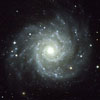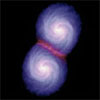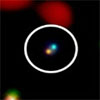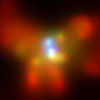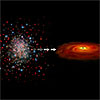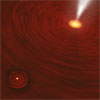CXC Home | Search | Help | Image Use Policy | Latest Images | Privacy | Accessibility | Glossary | Q&A
1. NOAO Optical and Chandra X-ray Sequence of M74
QuicktimeMPEG This sequence starts with an optical image of the galaxy M74 (a.k.a. NGC 628), which is about 32 million light years from Earth in the constellation Pisces. The view then adds Chandra's X-ray image and zooms onto one source in the galaxy's spiral arm. Astronomers believe this object, named CXOU J013651.1+154547, is a medium-size black hole, which would bridge the size gap between other known black holes.
[Runtime: 0:22]
(X-ray: NASA/CXC/U. of Michigan/J.Liu et al.; Optical: NOAO/AURA/NSF/T.Boroson)
Related Chandra Images:
QuicktimeMPEG This sequence starts with an optical image of the galaxy M74 (a.k.a. NGC 628), which is about 32 million light years from Earth in the constellation Pisces. The view then adds Chandra's X-ray image and zooms onto one source in the galaxy's spiral arm. Astronomers believe this object, named CXOU J013651.1+154547, is a medium-size black hole, which would bridge the size gap between other known black holes.
[Runtime: 0:22]
(X-ray: NASA/CXC/U. of Michigan/J.Liu et al.; Optical: NOAO/AURA/NSF/T.Boroson)
Related Chandra Images:
- Photo Album: M74
2. Simulation of a Galaxy Collision
QuicktimeMPEG Broadcast:
This visualization shows two spiral galaxies - each with supermassive black holes at their center - as they collide. In this simulation, the brightness represents gas density while the color indicates temperature in the gas distribution. The latest Chandra results suggest that such collisions may cause extreme black hole and galaxy growth in the early Universe, setting the stage for the birth of quasars. The time scale shown in the upper left of the simulation represents millions of years.
[Runtime: 0:41]
(Tiziana Di Matteo (MPE/CMU), Volker Springel (MPE) & Lars Hernquist (Harvard))
Related Chandra Images:
QuicktimeMPEG Broadcast:
- QuickTime movie (uncompressed)
- D1 (0.9 pixel aspect ratio)
- 720x486
- 29.97 fps
- file size = (387.3 MB)
This visualization shows two spiral galaxies - each with supermassive black holes at their center - as they collide. In this simulation, the brightness represents gas density while the color indicates temperature in the gas distribution. The latest Chandra results suggest that such collisions may cause extreme black hole and galaxy growth in the early Universe, setting the stage for the birth of quasars. The time scale shown in the upper left of the simulation represents millions of years.
[Runtime: 0:41]
(Tiziana Di Matteo (MPE/CMU), Volker Springel (MPE) & Lars Hernquist (Harvard))
Related Chandra Images:
3. Chandra's X-ray Image of Black Holes in the Early Universe
QuicktimeMPEG Broadcast:
This sequence begins with the Chandra Deep Field-North, the deepest X-ray image ever taken. Black holes that are also found in submillimeter observations, indicating active star formation in their host galaxies, are then marked. The view then zooms onto one pair of particularly close black holes (known as SMG 123616.1+621513). Astronomers believe these black holes and their galaxies are orbiting each other and will eventually merge. The sequence ends by showing an animation of this scenario.
[Runtime: 0:33]
(X-ray image: NASA/CXC/Penn State/D. Alexander et al.)
Related Chandra Images:
QuicktimeMPEG Broadcast:
- QuickTime movie (uncompressed)
- D1 (0.9 pixel aspect ratio)
- 720x486
- 29.97 fps
- file size = (274.5 MB)
This sequence begins with the Chandra Deep Field-North, the deepest X-ray image ever taken. Black holes that are also found in submillimeter observations, indicating active star formation in their host galaxies, are then marked. The view then zooms onto one pair of particularly close black holes (known as SMG 123616.1+621513). Astronomers believe these black holes and their galaxies are orbiting each other and will eventually merge. The sequence ends by showing an animation of this scenario.
[Runtime: 0:33]
(X-ray image: NASA/CXC/Penn State/D. Alexander et al.)
Related Chandra Images:
4. Best of Chandra Images: Black Holes, Jets & Quasars
QuicktimeMPEG Black holes are so dense and compact that nothing -- not even light -- can escape. Just outside their grasp, though, black holes can alight galaxies by expelling infalling gas and stars (known as quasars), or generate powerful high-energy jets flowng from spiraling disks that surround them. This video presents some of the best Chandra observations of black holes, jets & quasars.
[Runtime: 1:11]
(NASA/CXC/SAO)
QuicktimeMPEG Black holes are so dense and compact that nothing -- not even light -- can escape. Just outside their grasp, though, black holes can alight galaxies by expelling infalling gas and stars (known as quasars), or generate powerful high-energy jets flowng from spiraling disks that surround them. This video presents some of the best Chandra observations of black holes, jets & quasars.
[Runtime: 1:11]
(NASA/CXC/SAO)
5. Scenario Dismissed by Chandra Results
QuicktimeMPEG Broadcast:
This sequence of artist's renderings shows the scenario ruled out by the latest Chandra results. In this model, a cluster with both low (red) and high (blue) mass stars is drawn toward the black hole. Eventually, the strong gravitational forces would rip the cluster apart, sending its constituent stars into orbit around the black hole.
[Runtime: 0:10]
View Stills
(Illustrations: NASA/CXC/M.Weiss)
Related Chandra Images:
QuicktimeMPEG Broadcast:
- QuickTime movie (uncompressed)
- D1 (0.9 pixel aspect ratio)
- 720x486
- 29.97 fps
- file size = (32.9 MB)
This sequence of artist's renderings shows the scenario ruled out by the latest Chandra results. In this model, a cluster with both low (red) and high (blue) mass stars is drawn toward the black hole. Eventually, the strong gravitational forces would rip the cluster apart, sending its constituent stars into orbit around the black hole.
[Runtime: 0:10]
View Stills
(Illustrations: NASA/CXC/M.Weiss)
Related Chandra Images:
- Photo Album: Sagittarius A*
6. Animation of Stars Forming Around Black Hole
QuicktimeMPEG Broadcast:
This animation shows a disk of red and yellow gas around a supermassive black hole. As the view pulls back, the formation of stars in the outer regions of the disk is seen. These massive stars form when the gas becomes unstable, despite the black hole's enormous gravitational influence, and collapses inwards.
[Runtime: 0:23]
View Stills
(NASA/CXC/A.Hobart)
Related Chandra Images:
QuicktimeMPEG Broadcast:
- QuickTime movie (uncompressed)
- D1 (0.9 pixel aspect ratio)
- 720x486
- 29.97 fps
- file size = (493.7 MB)
This animation shows a disk of red and yellow gas around a supermassive black hole. As the view pulls back, the formation of stars in the outer regions of the disk is seen. These massive stars form when the gas becomes unstable, despite the black hole's enormous gravitational influence, and collapses inwards.
[Runtime: 0:23]
View Stills
(NASA/CXC/A.Hobart)
Related Chandra Images:
- Photo Album: Sagittarius A*


